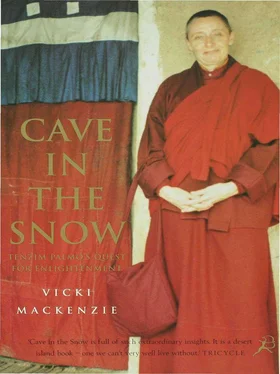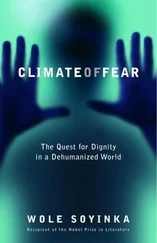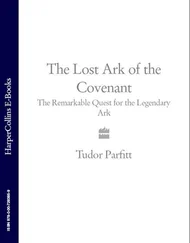She continued: We found Mrs Bedi in the kitchen standing over a stove which was gushing out smoke with no heat coming from it at all. She was cooking porridge made with some Tibetan cheese. It was disgusting. She was a tall, plump woman in her mid fifties with blue eyes, an aquiline nose and grey hair pulled back in a bun. I remember she was wearing a maroon sari made of heavy woollen cloth, which made her look enormous.’
Freda Bedi was indeed a fascinating character, now a legend within Tibetan Buddhist circles. She too had led a colourful life. Born and brought up among the English upper classes, she had scandalized society by marrying an Indian she had met at Oxford before returning to the subcontinent to live with him. She followed this by taking up arms against her own country to fight the British in the independence movement, and was duly imprisoned for her pains. On her release, a heroine to her newly adopted country, her career took another dramatic twist when she was dispatched by the Central Social Welfare board to work with the newly arrived Tibetan refugees who were pouring into India in the wake of the Dalai Lama’s flight in 1959. Once ensconced among them, Freda had been so caught up by their plight and the potency of their message that in middle age, married and with five children (one of whom is Kabir Bedi, the famous Indian movie star), she had become a nun, the first Western woman ever to do so, taking the name Khechok Palmo.
’She was definitely a character – a strange mixture of Indian and English county. She never completely shed her roots. Everyone called her Mummy. I loved her very much,’ commented Tenzin Palmo. ‘The thing was she was very good at initiating ideas and excellent at getting money. At that time Tibetans were not yet organized, did not know English or about aid agencies and how to apply for help. Freda Bedi on the other hand was extremely organized and excellent at presenting her case. She got a lot of money. Her main fault, however, was that instead of buying property, which was very cheap then, and getting herself established, she dribbled the funds away on buying things like bedlinen, towels and this and that. She was not very practical. After a few years the land prices had sky-rocketed and the aid agencies were giving to others and she lost out. Still, the nunnery that she started is still going and so many Tibetan teachers who came to the West, like Trungpa, got their basic English at her school. So in fact she contributed a lot.’
Dalhousie was a beautiful place, spread over a number of hills covered in stately pine trees and inhabited by gangs of raucous monkeys. It had been established as a hill station by Lord Dalhousie in 1854, and by the time Tenzin Palmo got there it was full of decaying officers’ clubs, Anglican churches and English brick houses with high ceilings, large verandas and gardens filled with roses and dahlias – now relics from the Raj. At 7,000 feet it not only provided blessed relief from the searing summer sun, but also commanded breathtaking views of the Indian plains on one side and the Himalayan foothills on the other.
Tenzin Palmo had managed to time her journey to arrive at an interesting moment in history – the point where some 5,000 Tibetans had congregated in Dalhousie, making it the major refugee centre in India. Later they decamped and went to Dharamsala, to southern India and other settlements, but in 1963 they were there in their masses, valiantly re-establishing replicas of the great monasteries that had flourished in their homeland, Sera and Drepung, and trying to resurrect at least the remnants of their unique culture. ‘It was a lovely place then. There were no cars and it had a very special atmosphere. In the morning and the evening all the Tibetans would be out doing kora around the hills,’ Tenzin Palmo remembered.
Interesting it may have been, easy it wasn’t. The Tibetans had witnessed unspeakable atrocities. They had seen their mighty monasteries sacked, their monks and high lamas tortured; they had been traumatized by the dangerous journey out; they were destitute, displaced and in a pitiful state. ‘They were desperately poor and the conditions they were living in were dreadful. They had tents made from flour sacks which of course were hopelessly inadequate and they were trying to make their butter tea from lard. The Indian heat was also terrible for them after the crisp coldness of Tibet. Many of them got sick and died.’
The situation that she found herself in was not much better. She was put first on to the covered veranda of the nunnery that Freda Bedi had started for Kargyu nuns, and then into a little room by herself. ‘It was cold, freezing cold, and when it rained, it rained outside and in. It was so wet in fact that I had to sleep under the bed. And then there were the rats. They were everywhere. They were also enormous and would eat everything, including cloth and my prayer beads. They used to keep me awake at night by jumping on me. Actually I didn’t mind the rats as much as the spiders. I remember there was one huge spider with little glassy eyes. That was far worse.’
Every day she walked round the hill from the nunnery to the quaintly named ‘Young Lamas’ Home School’, which Freda Bedi had set up in one of the abandoned but magnificent former English houses. It had many rooms, was perched right on the edge of a hill and was surrounded by a beautiful garden. (The first of the Dharma Bums, the American poet Allen Ginsberg, had been there just before Tenzin Palmo, gathering the inspiration which would launch a cult.) Tenzin Palmo was given two jobs, acting as Freda Bedi’s secretary and teaching the young lamas basic English. Her pupils were not ordinary lamas, however, they were the tulkus, the recognized reincarnations of previous high spiritual masters, in whose hands lay the future of Tibetan Buddhism itself. Choygam Trungpa was among the many future eminent teachers in the West who learnt their first lessons in rudimentary English here.
In spite of the spartan living conditions, Tenzin Palmo loved it, as her letter to her aunt back in England reveals:
My dear Auntie Joan,
Many, many thanks for your 2 letters, really I loved receiving them once I could decipher your handwriting knowing Tibetan script helped! …
I am now teaching some of the beginners’ class all morning. There is the youngest lama of 12, a lama of 25 who is so sweet and a very good lama but rather hopeless at English, and also there is a lama of 22 who is really so gorgeous and was working on road-making for 2 years before coming to the school so his physique is wow! Added to this he is very intelligent and is learning very fast. It is like a village school with lots of classes going on in the same room – rather noisy but great fun.
We have 2 cats and a small Tibetan dog at the school and we also have a dog named Shu-shu whose mother and brother were both eaten by leopards. We love her very much but she is most definitely lacking in social graces having a marked appetite for cow dung and passing Indian shins. She sleeps on my bed and when asleep is a lovely dog. Anyway, she has character, we tell ourselves
…
At the moment the nuns are holding their evening puja.
The storm has cut our electricity off so there is only the flickering lights of the butter-lamps for them to see by. It really looks like Tibet now. From my little room I can hear the sounds of the bells, drum and chanting very clearly. It is very beautiful. We often go to the lamas’ pujas because it is really very good and their symbolic hand movements are lovely and fascinating.
Thank you for offering to send me things, but really there is nothing that I need and also customs duty on everything is 100%. Give my love to Arthur, Graham, Martin and Kim and you of course, Diane.
As her letter also revealed, Tenzin Palmo’s eye was still very much drawn to the attractions of the opposite sex. She was twenty, attractive, vital, and the split between the two sides of herself had not been resolved. As though to emphasize her dilemma, one evening a nun brought her three letters. One was from a former Sinhalese boyfriend lamenting the fact that she’d gone away and beseeching her to return to England to marry him. The second was from another Japanese boy who said he had changed his mind about inter-racial marriages never working and would she mind coming back to him. And the third was from her Japanese ‘fiance’, saying that the conditions she had written about sounded so dreadful that she must immediately fly to Japan – and that he was sending her a ticket.
Читать дальше












